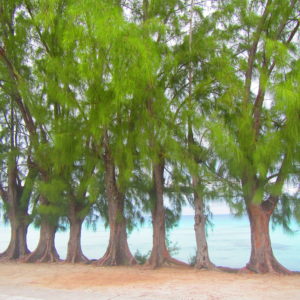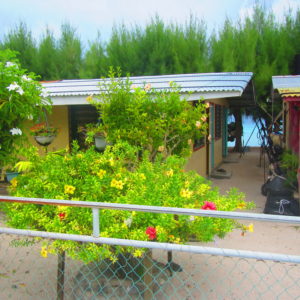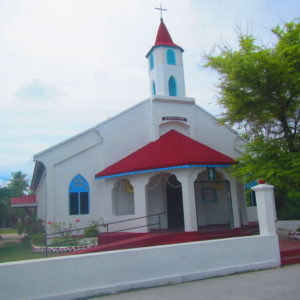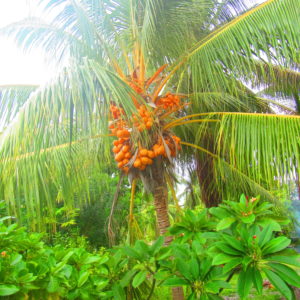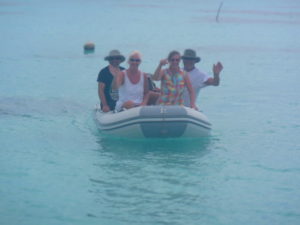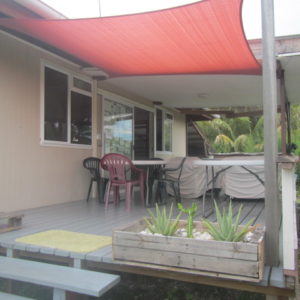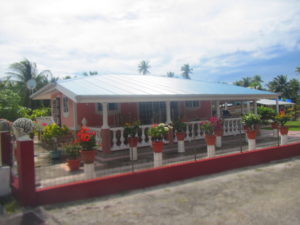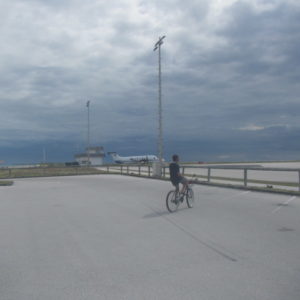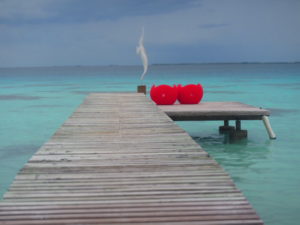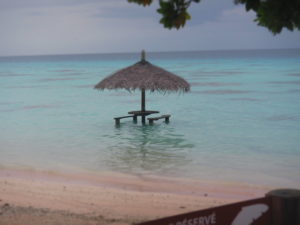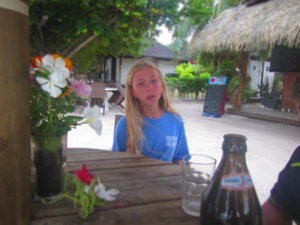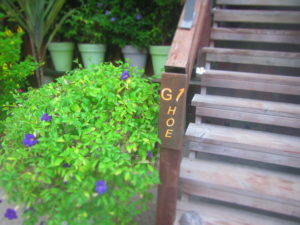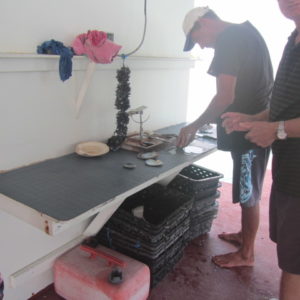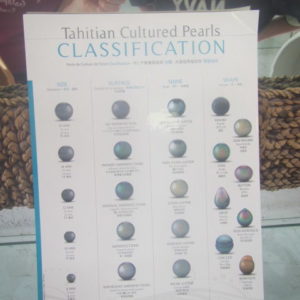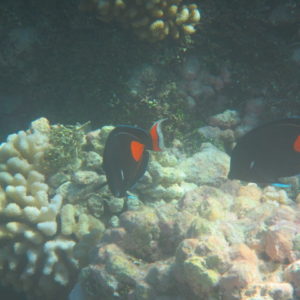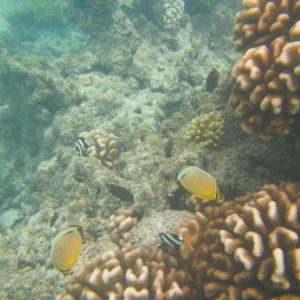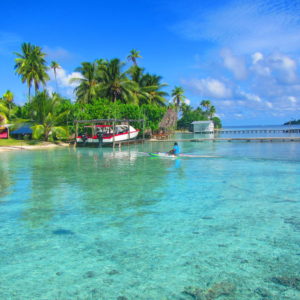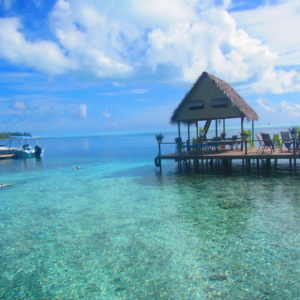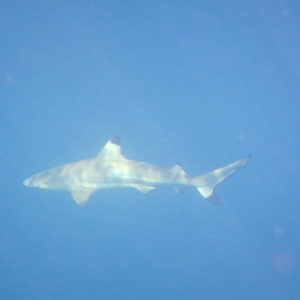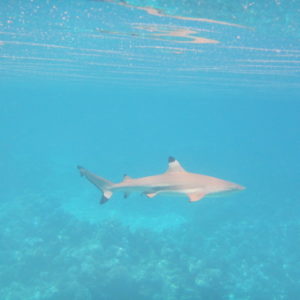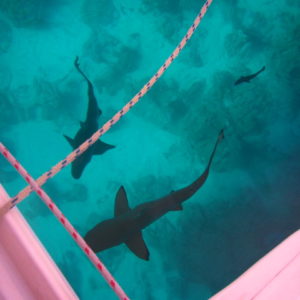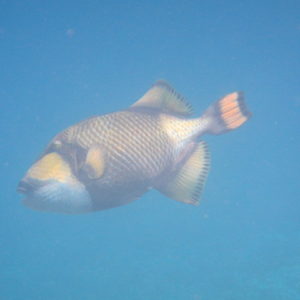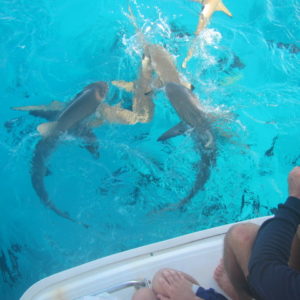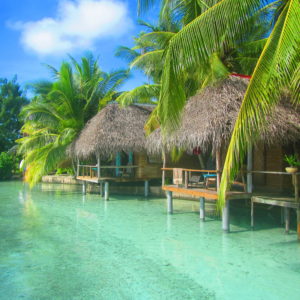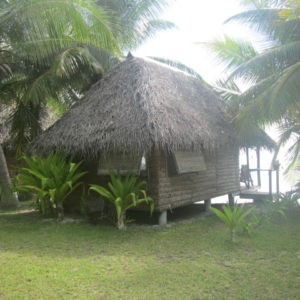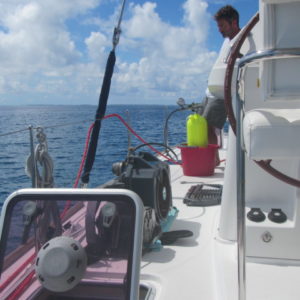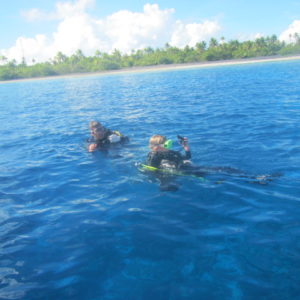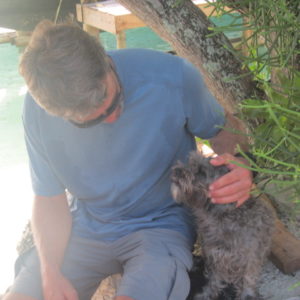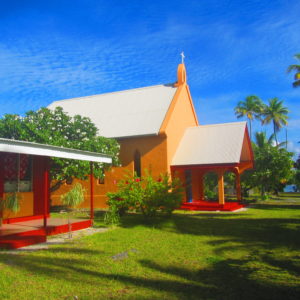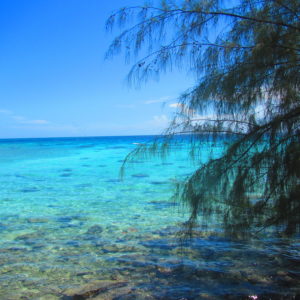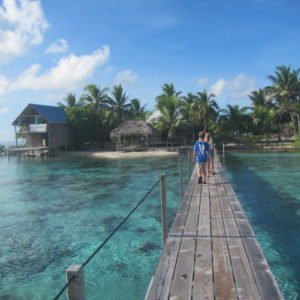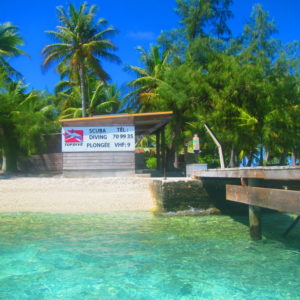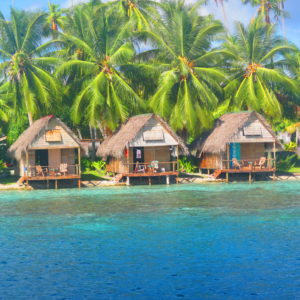North Fakarava
Fakarava, Tuamotus
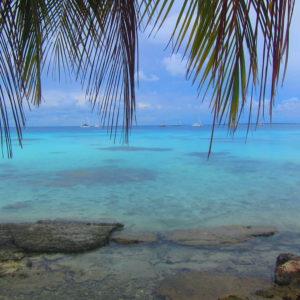
Our sail to the Tuamotus took us four nights and was relatively uneventful. But, looking at our Yellow Brick position, people would have thought we were still in the middle of the ocean when we arrived; these islands are like specks in Horton Hears a Who. Heck, I had never heard of them before this trip, and I had no idea what to expect. The repairs I stitched on the jib continued to hold up and our newly-fixed Genniker was much appreciated on this sail. We were headed specifically for Fakarava Island, which is actually classified as a Natural Biosphere Reserve by Unesco. We were headed for the land of exceptional scuba diving—yippee!
The Tuamotus are somewhat strange for cruisers. They have “cuts” in the atolls at a few places, and that is how you make it into the protected middle. The land itself is not wide at all but goes around nearly completing a circle. You have to be careful entering these cuts because if the tide is coming out, the current can be very strong, and your engine(s) won’t be able to get you in there. Also, the waves can be very large as well in some of these passages. We entered Fakarava’s north cut at the proper tide time, and this cut turned out to be quite easy.
The name of the town at the northern pass is called Rotoava. It is a nice little village with a few restaurants, some pensions, two small grocery stores, some artisan craft stores, a Tahitian pearl jewelry shop (the woman makes her own jewelry), a few dive shops, a handful of pearl farms and a small airport. There is also a Yacht Services Company that is owned and operated out of the home of a nice French family with two young girls. They rent bicycles, sell sodas and fresh juices, and allow cruisers to use the Internet on their home’s deck. That is essentially the extent of the town. One night we tried to have dinner at a restaurant and the power went out in the entire village! Left with few menu options, we opted to return to the boat and cook. The good part about living on a boat—power when land doesn’t have it! We eventually ate at this restaurant which really only served paninis and crepes. There was also a woman on the island who would make you pizzas out of her house for $12 each (individual-sized) but we never could find her house and you had to order early in the morning for an evening pick-up. The only other restaurant in walking distance was very good, and you could get two nice pieces of seasoned, grilled tuna with French Fries (with Garlic Butter) for only $10. Not bad! They had steak and fries too for $10, and salads that were pretty good.
Rotoava, Fakarava
Nina: Steve, Lynda, and their crew, Peter and Karen
Lunch at one of the few restaurants on the island
Fakarava Yacht Services (at Stephanie and Aldrich’s house)
The house of an owner of a pearl farm
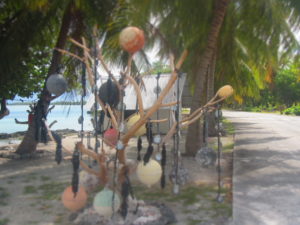
The Fakarava Airport
A day out exploring on bikes
Tiny hermit crabs
There was a nice pension we rode our bikes to as well. They had a snack bar on the water and a very nice atmosphere. They had a “fancy” restaurant at night, but I am not sure if anyone ever ate there. There were two small grocery stores on the island and I was able to get grapes and yellow watermelon—but only on the days when a ship came in with fresh produce (about once a week). By the end of the day, almost all of it would be gone from the stores! Still no tomatoes though…
The Pension–nice place!
Interesting. Can you imagine checking into your room called: “GI Hoe?”
Many of the kids in Fakarava north ride their bicycles to and from school (parents usually ride the young kids in on the backs of their bicycles), and overall, it is a nice, quaint town. Although most of the houses are very modest, many residents had beautifully landscaped yards and could be seen working on their gardens as you strolled through town. We rented bicycles one day and visited a pearl farm another, but much of our time here was spent in the water and under the water. I will say the pearl farm was worth the visit. We learned how black pearls come to be, and how they graft in a nucleus (from mussels in Mississippi of all places), and the oyster develops the pearl around it. An oyster can produce four pearls in its life (each one bigger than the other because of how they cultivate the oyster). But some oysters reject the graft and some produce inferior or no pearls. It is an interesting process.
Our Visit to the Pearl Farm
Because the passes on these islands have a huge tide filtering through them a few times a day, the coral in and around these passes is impressive and most days the visibility scuba diving is nothing short of spectacular. They actually consider some of these areas “coral gardens.” And because of this amazing coral, you also have incredible numbers and types of fish—and sharks. Sharks are everywhere and our dives were full of them. During our time in the Tuamotus, we saw HUNDREDS of sharks—white tip reef, black tip reef, nurse and gray sharks. At first it is a little disconcerting snorkeling and diving with so many sharks around, but THESE sharks have learned their place is lower on the chain than humans. They generally did not swim too closely to you, but occasionally they would come in fairly close out of curiosity (especially in the south part of the island which I’ll talk about next).
Some Fish While Snorkeling
We arranged a scuba dive with Vincent (at a local dive shop) and his boat captain on the northern part of the island. It ended up just being Dan, Ariana and me that day. We went to the most incredible reef I have ever had the pleasure of diving in. It was awesome! It was my favorite dive in 18 years of diving. The visibility was amazing, we saw numerous sharks cruising around, and the number of different reef fish was nothing short of spectacular. I have been diving in Hawaii, but this dive put my diving in Hawaii to shame. Hawaii’s visibility wasn’t nearly as good and I saw species of fish in the Tuamotus that I have never seen on any other dive. I especially loved the Napoleon fish. They are huge, curious, and come very close to you. They also have a Unicorn fish that has this horn coming out of its face. The fish is white, but when it gets parasites it wants other fish to eat, it swims to the bottom of the water and turns black so the fish know where the white parasites are. How amazing is that? Also, we finally had the opportunity to dive with Ariana. She did fantastic! Dan was beaming with pride. She was so comfortable in the water and seemed unfazed by the sharks, the depth (about 65 feet) or the current we were diving in.
Another day, we dove the pass. It was just Tim, on Belafonte, who was becoming scuba-certified during his time in Fakarava, and us diving. This was a unique dive. The current is incredibly strong, and our plan for the dive was to descend, level out, swim above the reef into the cut, hold on dearly to a rock so the current did not pull you away prematurely, watch the sharks for a little while, let go and let the current take you as you cruise above the reef watching the fish. It felt like we were flying. It was a neat dive, but I actually prefer being able to stay a bit longer in one place to look at all of the reef critters. Unlike Cozumel (which has current and is all drift diving), there was no way you could fight the current here to stop and look at something that intrigued you in the water. So, we flew above like we were on Soarin’ at Disney World.
We hung out with Bob and Lori on Barbara Jean and Tim and Magda on Belafonte a few days/evenings while we were in the north passage. We went out to lunch/dinner a few times and we also had a potluck on our boat and that was a fun evening as well. We were able to see the folks on Nina a bit too, and Dan scuba-dove to free their anchor from the reef that it ended up in. Finally, Gail and Jason (on Two Fish) rolled into the harbor and we went to their boat for a cocktail party our last evening in North Fakarava. They tried to have people over the night before that, but it was ROUGH in the anchorage so we chose to move it to another night. It is so strange to be seasick at anchor…
South Fakarava
We were off to South Fakarava, which allowed us to stay within the protected atoll the entire time. The village in the south is called Tetamanu, and it is SMALL. There are a few houses and a small dive “resort” with a dock and some huts over the reef. There is also another small house (if that’s what you want to call it) that is only habited by Top Dive instructors when there are divers.
If I were to describe South Fakarava in one word it would be “sharks.” If I had another word, it would be “clarity.” The water was so clear, which meant that you could see all of the sharks lurking underneath your boat. We always had at least five (three black-tip reef and two gray sharks) who treated our catamaran like a shady reef. We also had amazing fish under our boat, and at one point, we had a large Napoleon Fish. Although we went on to snorkel and dive with tons of sharks down here in the South Pass, I think we all felt a little uncomfortable swimming right off of our boat with all of them hovering there. Cruisers throw their food scraps into the water so trash doesn’t get too stinky. Fish usually get to it pretty quickly. I guess we just didn’t want a shark to take a nibble on the kids or us before they decided we weren’t table scraps! So after a day, we decided not to swim right off of our boat. After that, anytime I would put a bit of chicken fat, an old hot dog, etc into the water, it took all of about three seconds for the fish and sharks to attack it. A little disconcerting, but fun to watch!
Some Sharks and a Cute Fish
A Feeding Frenzy
The first day, we all snorkeled together over at the pass (the cut in the atoll that brings in/lets out great current with the tides). One of the funniest moments was when Ari, Dan and I were snorkeling (our dinghy was tied to Dan) and Ryan, after having taken a dip in the water, was back in the dinghy with his feet dangling out in the water. Snorkeling, we saw this gray shark heading straight for Ryan’s toes. Dan popped his head out of the water and said: “Ryan, pull your feet into the boat.” As soon as Ryan did, the shark did an about face and stopped pursuing Ryan’s little smoked sausages! That was really the only uncomfortable moment while snorkeling—but the sharks didn’t actually bother us snorkelers—only that yummy “food” dangling just at the surface.
The Village of Tetamanu
We knew we wanted to dive this pass as well, and here, you did not have to go in a power boat with a dive instructor because it was easy to dinghy over. No one would rent us a BC and regulator for liability reasons (strange) so all three of us could dive together (Dan and I have equipment but Ari does not), so we had to split up. Also, our father-in-law had bought us three new scuba tanks prior to our trip. We had them filled by Vincent in North Fakarava and we realized upon arrival in the south that one of our tanks has a leak in it. There was no air left! This motivated Dan to break out the dive compressor and attempt to fill our other tanks fully. Dan had popped the breaker when he tried it prior to our trip on 10 volt, so this time he tried plugging it straight in to 15 volt. It worked! We now can fill our own tanks. How exciting!
The first day of diving, Ari and Ryan dropped Dan and me off at the pass, we waited on the surface for them to dinghy up at the dock, and we descended. It was an amazing dive! I must have seen at least 100 sharks and the visibility was wonderful. Again, this was a drift dive, but more like Cozumel. You could easily fight the current to look at all of the reef fish and the sharks. We drifted right up to the dock, where the kids were playing Travel Battleship while waiting for us.
The next day, Ryan and I dropped Ariana and Dan off for their dive. They had a good time, but their visibility wasn’t nearly as good as the day before and they only saw a handful of sharks. And terribly, Dan ruptured his eardrum on this dive. Once it ruptured, he had relief, but he really shouldn’t have gone diving that day. On our dive, he took a good solid 10 minutes to ascend because his ears were bothering him so badly. He just wanted to make sure Ariana got a chance to dive—what a great Dad! He took antibiotics, but now he can’t dive for some time. He is hoping to be able to in Nuie. Ari and I will need to be dive buddies for a while!
Getting the Dive Compressor to Work!
Ari and Dan’s Day to Dive
The Resident Dog of the Small Dive Resort: “Lucky,” just like our Fish, with Dan.
The Church, Built in 1874
We spent one day walking the small island and crossing parts of the atoll. We also had a nice ping pong challenge on the picnic table at the deserted Top Dive house. (We have a portable table ping pong set.) That was a lot of fun.
Ping Pong Fun
The Jelly Fish We Saw on the Beach–so Bright!
Wandering Around the Small Island
Top Dive’s Area (When They Have Divers)
I am so glad we went to South Fakarava. We debated whether it was worth the 35-mile trip, but it really was. For two nights, we were the only other boat there! It was our own secluded oasis, and we were lucky to have that oasis include crystal clear waters and beautiful reef. It was simply amazing.
A Strange and Pretty Sunset
I Love These Little Huts!
From there, we were off to Tahiti! We could depart right out of the South Pass of the atoll when the tide was slack, and luckily, it was only a two-night passage…
